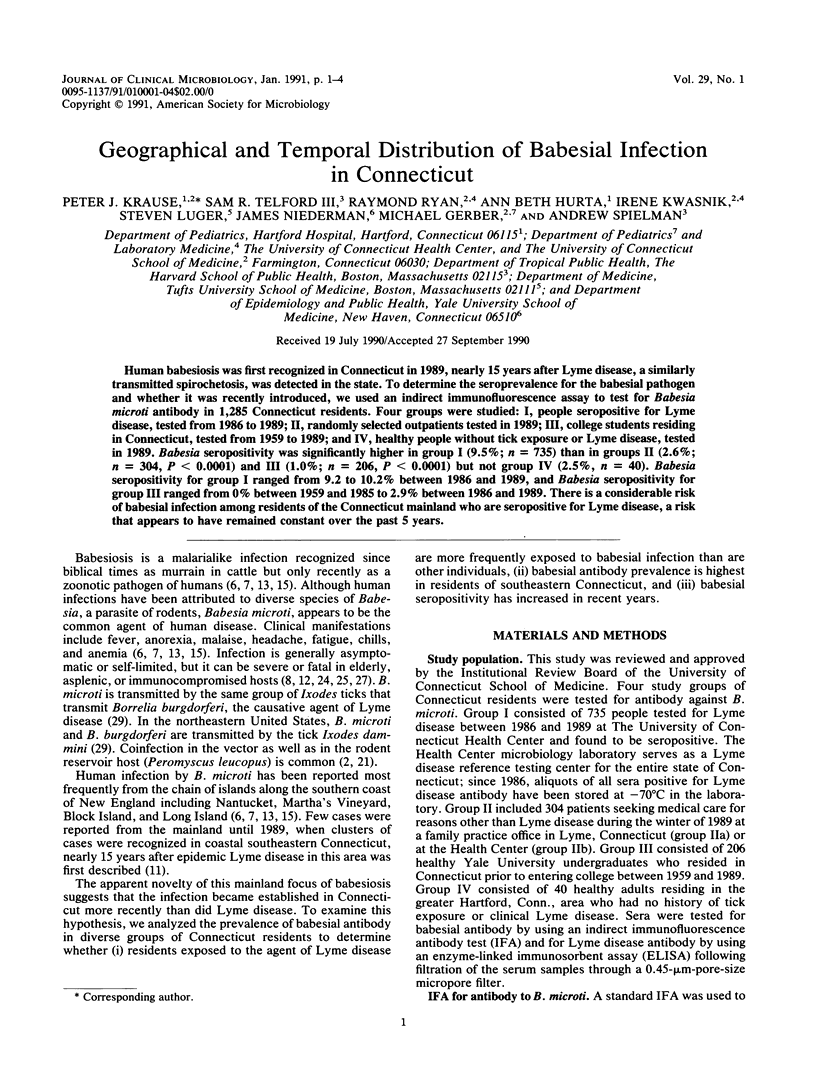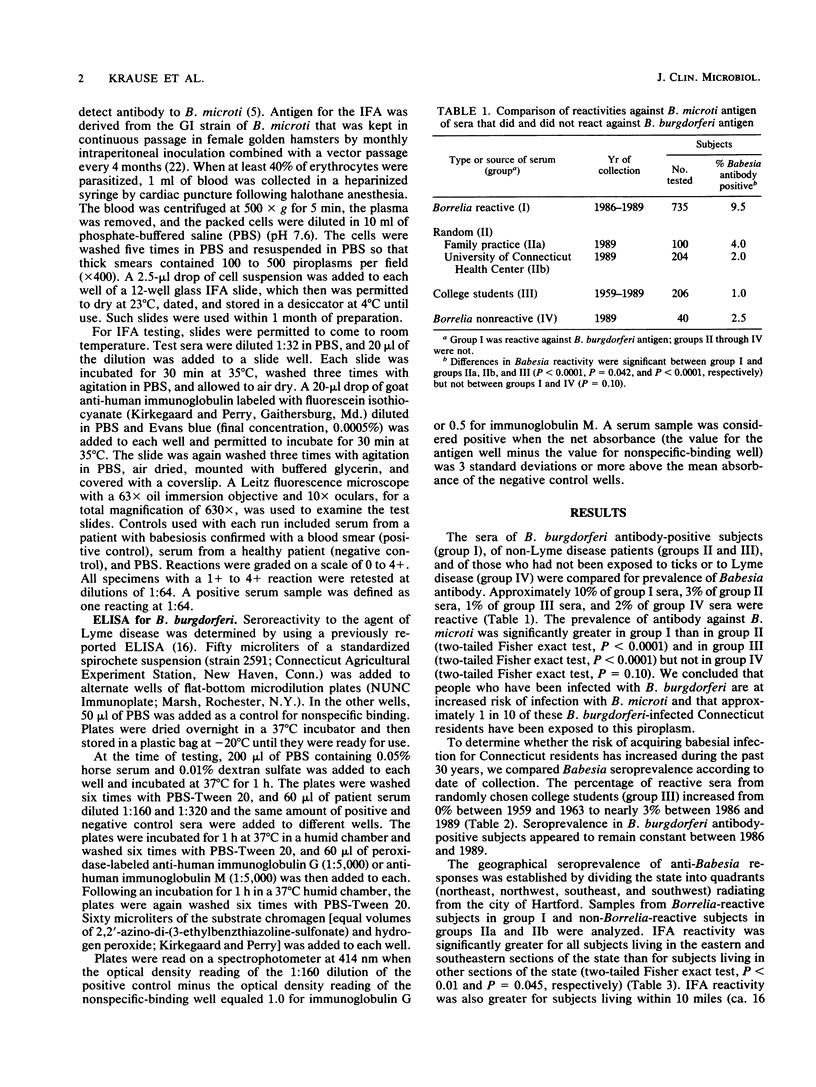Abstract
Human babesiosis was first recognized in Connecticut in 1989, nearly 15 years after Lyme disease, a similarly transmitted spirochetosis, was detected in the state. To determine the seroprevalence for the babesial pathogen and whether it was recently introduced, we used an indirect immunofluorescence assay to test for Babesia microti antibody in 1,285 Connecticut residents. Four groups were studied: I, people seropositive for Lyme disease, tested from 1986 to 1989; II, randomly selected outpatients tested in 1989; III, college students residing in Connecticut, tested from 1959 to 1989; and IV, healthy people without tick exposure or Lyme disease, tested in 1989. Babesia seropositivity was significantly higher in group I (9.5%; n = 735) than in groups II (2.6%; n = 304, P less than 0.0001) and III (1.0%; n = 206, P less than 0.0001) but not group IV (2.5%, n = 40). Babesia seropositivity for group I ranged from 9.2 to 10.2% between 1986 and 1989, and Babesia seropositivity for group III ranged from 0% between 1959 and 1985 to 2.9% between 1986 and 1989. There is a considerable risk of babesial infection among residents of the Connecticut mainland who are seropositive for Lyme disease, a risk that appears to have remained constant over the past 5 years.
Full text
PDF



Selected References
These references are in PubMed. This may not be the complete list of references from this article.
- Anderson J. F., Johnson R. C., Magnarelli L. A., Hyde F. W. Involvement of birds in the epidemiology of the Lyme disease agent Borrelia burgdorferi. Infect Immun. 1986 Feb;51(2):394–396. doi: 10.1128/iai.51.2.394-396.1986. [DOI] [PMC free article] [PubMed] [Google Scholar]
- Anderson J. F., Johnson R. C., Magnarelli L. A., Hyde F. W., Myers J. E. Peromyscus leucopus and Microtus pennsylvanicus simultaneously infected with Borrelia burgdorferi and Babesia microti. J Clin Microbiol. 1986 Jan;23(1):135–137. doi: 10.1128/jcm.23.1.135-137.1986. [DOI] [PMC free article] [PubMed] [Google Scholar]
- Benach J. L., Coleman J. L., Habicht G. S., MacDonald A., Grunwaldt E., Giron J. A. Serological evidence for simultaneous occurrences of Lyme disease and babesiosis. J Infect Dis. 1985 Sep;152(3):473–477. doi: 10.1093/infdis/152.3.473. [DOI] [PubMed] [Google Scholar]
- Benezra D., Brown A. E., Polsky B., Gold J. W., Armstrong D. Babesiosis and infection with human immunodeficiency virus (HIV) Ann Intern Med. 1987 Dec;107(6):944–944. doi: 10.7326/0003-4819-107-6-944_1. [DOI] [PubMed] [Google Scholar]
- Chisholm E. S., Ruebush T. K., 2nd, Sulzer A. J., Healy G. R. Babesia microti infection in man: evaluation of an indirect immunofluorescent antibody test. Am J Trop Med Hyg. 1978 Jan;27(1 Pt 1):14–19. doi: 10.4269/ajtmh.1978.27.14. [DOI] [PubMed] [Google Scholar]
- Dammin G. J., Spielman A., Benach J. L., Piesman J. The rising incidence of clinical Babesia microti infection. Hum Pathol. 1981 May;12(5):398–400. doi: 10.1016/s0046-8177(81)80020-2. [DOI] [PubMed] [Google Scholar]
- Desforges J. F., Quimby F. Editorial: Babesia abroad. N Engl J Med. 1976 Jul 8;295(2):103–104. doi: 10.1056/NEJM197607082950211. [DOI] [PubMed] [Google Scholar]
- Filstein M. R., Benach J. L., White D. J., Brody B. A., Goldman W. D., Bakal C. W., Schwartz R. S. Serosurvey for human babesiosis in New York. J Infect Dis. 1980 Apr;141(4):518–521. doi: 10.1093/infdis/141.4.518. [DOI] [PubMed] [Google Scholar]
- Golightly L. M., Hirschhorn L. R., Weller P. F. Fever and headache in a splenectomized woman. Rev Infect Dis. 1989 Jul-Aug;11(4):629–637. doi: 10.1093/clinids/11.4.629. [DOI] [PubMed] [Google Scholar]
- Healy G. R. Babesia infections in man. Hosp Pract. 1979 Jun;14(6):107-11, 115-6. doi: 10.1080/21548331.1979.11707564. [DOI] [PubMed] [Google Scholar]
- Magnarelli L. A., Meegan J. M., Anderson J. F., Chappell W. A. Comparison of an indirect fluorescent-antibody test with an enzyme-linked immunosorbent assay for serological studies of Lyme disease. J Clin Microbiol. 1984 Aug;20(2):181–184. doi: 10.1128/jcm.20.2.181-184.1984. [DOI] [PMC free article] [PubMed] [Google Scholar]
- Marcus L. C., Steere A. C., Duray P. H., Anderson A. E., Mahoney E. B. Fatal pancarditis in a patient with coexistent Lyme disease and babesiosis. Demonstration of spirochetes in the myocardium. Ann Intern Med. 1985 Sep;103(3):374–376. doi: 10.7326/0003-4819-103-3-374. [DOI] [PubMed] [Google Scholar]
- Mather T. N., Telford S. R., 3rd, Moore S. I., Spielman A. Borrelia burgdorferi and Babesia microti: efficiency of transmission from reservoirs to vector ticks (Ixodes dammini). Exp Parasitol. 1990 Jan;70(1):55–61. doi: 10.1016/0014-4894(90)90085-q. [DOI] [PubMed] [Google Scholar]
- Piesman J., Donahue J. G., Mather T. N., Spielman A. Transovarially acquired Lyme disease spirochetes (Borrelia burgdorferi) in field-collected larval Ixodes dammini (Acari: Ixodidae). J Med Entomol. 1986 Mar 31;23(2):219–219. doi: 10.1093/jmedent/23.2.219. [DOI] [PubMed] [Google Scholar]
- Piesman J., Mather T. N., Dammin G. J., Telford S. R., 3rd, Lastavica C. C., Spielman A. Seasonal variation of transmission risk of Lyme disease and human babesiosis. Am J Epidemiol. 1987 Dec;126(6):1187–1189. doi: 10.1093/oxfordjournals.aje.a114757. [DOI] [PubMed] [Google Scholar]
- Piesman J., Mather T. N., Telford S. R., 3rd, Spielman A. Concurrent Borrelia burgdorferi and Babesia microti infection in nymphal Ixodes dammini. J Clin Microbiol. 1986 Sep;24(3):446–447. doi: 10.1128/jcm.24.3.446-447.1986. [DOI] [PMC free article] [PubMed] [Google Scholar]
- Piesman J., Spielman A. Babesia microti: infectivity of parasites from ticks for hamsters and white-footed mice. Exp Parasitol. 1982 Apr;53(2):242–248. doi: 10.1016/0014-4894(82)90065-0. [DOI] [PubMed] [Google Scholar]
- Popovsky M. A., Lindberg L. E., Syrek A. L., Page P. L. Prevalence of Babesia antibody in a selected blood donor population. Transfusion. 1988 Jan-Feb;28(1):59–61. doi: 10.1046/j.1537-2995.1988.28188127955.x. [DOI] [PubMed] [Google Scholar]
- Reubush T. K., 2nd, Cassaday P. B., Marsh H. J., Lisker S. A., Voorhees D. B., Mahoney E. B., Healy G. R. Human babesiosis on Nantucket Island. Clinical features. Ann Intern Med. 1977 Jan;86(1):6–9. doi: 10.7326/0003-4819-86-1-6. [DOI] [PubMed] [Google Scholar]
- Rosner F., Zarrabi M. H., Benach J. L., Habicht G. S. Babesiosis in splenectomized adults. Review of 22 reported cases. Am J Med. 1984 Apr;76(4):696–701. doi: 10.1016/0002-9343(84)90298-5. [DOI] [PubMed] [Google Scholar]
- Ruebush T. K., 2nd, Chisholm E. S., Sulzer A. J., Healy G. R. Development and persistence of antibody in persons infected with Babesia microti. Am J Trop Med Hyg. 1981 Jan;30(1):291–292. doi: 10.4269/ajtmh.1981.30.291. [DOI] [PubMed] [Google Scholar]
- Ruebush T. K., 2nd, Juranek D. D., Chisholm E. S., Snow P. C., Healy G. R., Sulzer A. J. Human babesiosis on Nantucket Island. Evidence for self-limited and subclinical infections. N Engl J Med. 1977 Oct 13;297(15):825–827. doi: 10.1056/NEJM197710132971511. [DOI] [PubMed] [Google Scholar]
- Spielman A., Wilson M. L., Levine J. F., Piesman J. Ecology of Ixodes dammini-borne human babesiosis and Lyme disease. Annu Rev Entomol. 1985;30:439–460. doi: 10.1146/annurev.en.30.010185.002255. [DOI] [PubMed] [Google Scholar]
- Steketee R. W., Eckman M. R., Burgess E. C., Kuritsky J. N., Dickerson J., Schell W. L., Godsey M. S., Jr, Davis J. P. Babesiosis in Wisconsin. A new focus of disease transmission. JAMA. 1985 May 10;253(18):2675–2678. doi: 10.1001/jama.253.18.2675. [DOI] [PubMed] [Google Scholar]


